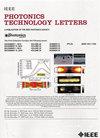High-Sensitivity Optical Fiber Mach-Zehnder Interferometer Sensor Based on Eight-Core Fiber
IF 2.3
3区 工程技术
Q2 ENGINEERING, ELECTRICAL & ELECTRONIC
引用次数: 0
Abstract
A high-sensitivity optical fiber curvature sensor based on eight-core fiber (ECF) is proposed and demonstrated. The sensor is fabricated by directly fusing a segment of ECF between two single-mode fibers (SMFs), forming a Mach-Zehnder interferometer (MZI) in an SMF-ECF-SMF structure. Due to the mode field mismatch between ECF and SMF modes, the fundamental mode of SMF is excited to higher-order modes and coupled into ECF to detect the external environment. The cores of the ECF present a基于八芯光纤的高灵敏度光纤马赫-泽恩德干涉仪传感器
本文章由计算机程序翻译,如有差异,请以英文原文为准。
求助全文
约1分钟内获得全文
求助全文
来源期刊

IEEE Photonics Technology Letters
工程技术-工程:电子与电气
CiteScore
5.00
自引率
3.80%
发文量
404
审稿时长
2.0 months
期刊介绍:
IEEE Photonics Technology Letters addresses all aspects of the IEEE Photonics Society Constitutional Field of Interest with emphasis on photonic/lightwave components and applications, laser physics and systems and laser/electro-optics technology. Examples of subject areas for the above areas of concentration are integrated optic and optoelectronic devices, high-power laser arrays (e.g. diode, CO2), free electron lasers, solid, state lasers, laser materials'' interactions and femtosecond laser techniques. The letters journal publishes engineering, applied physics and physics oriented papers. Emphasis is on rapid publication of timely manuscripts. A goal is to provide a focal point of quality engineering-oriented papers in the electro-optics field not found in other rapid-publication journals.
 求助内容:
求助内容: 应助结果提醒方式:
应助结果提醒方式:


